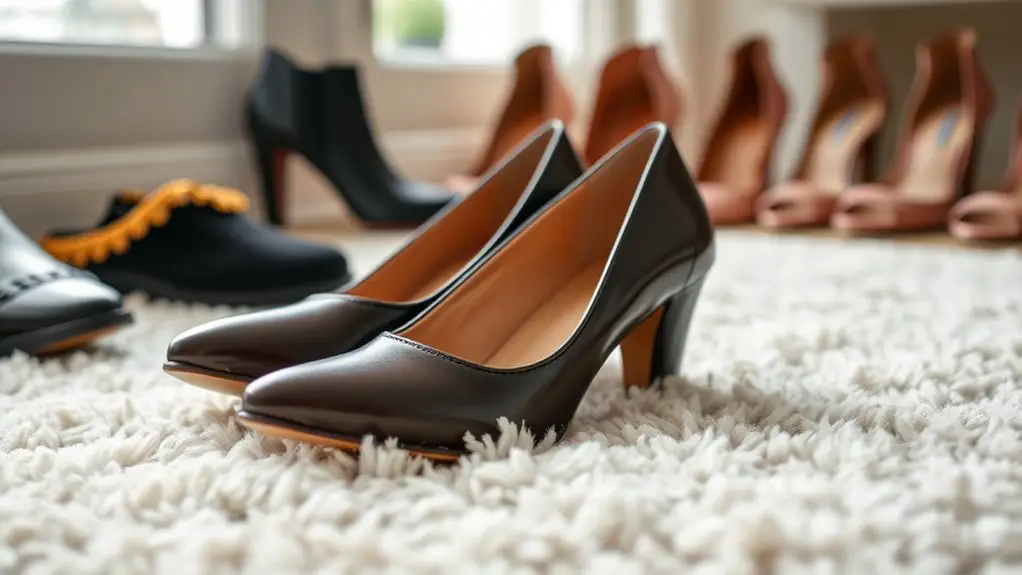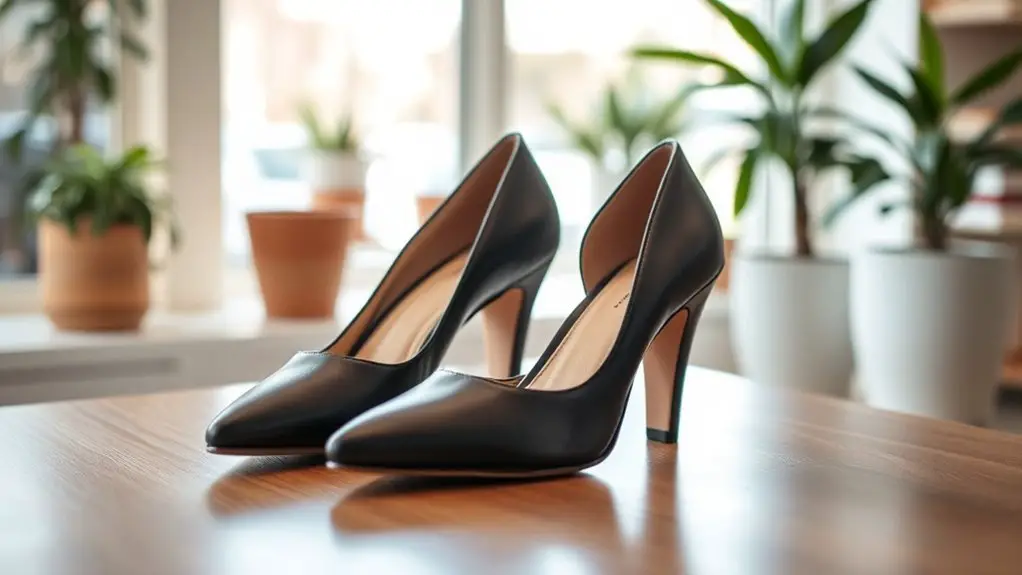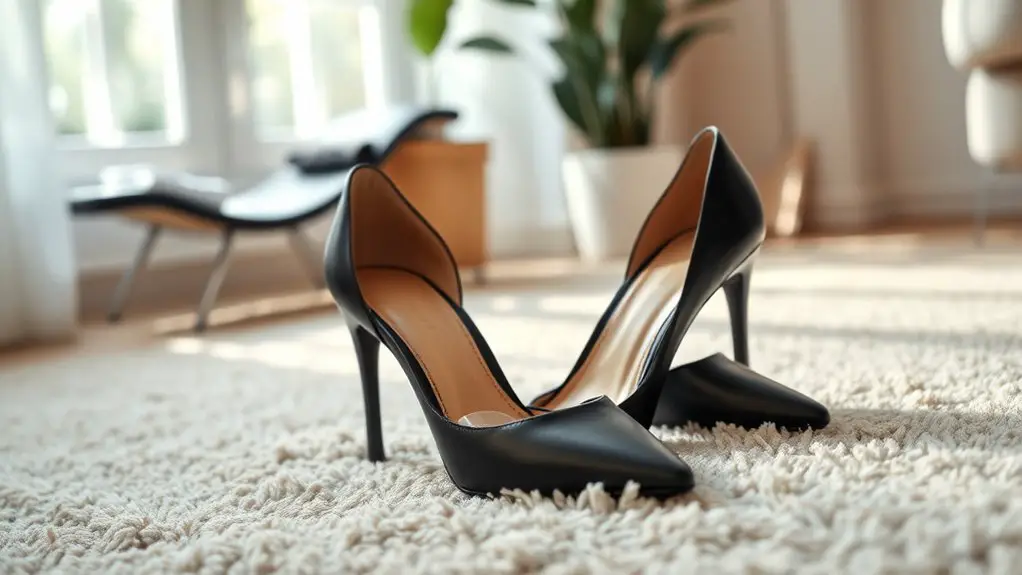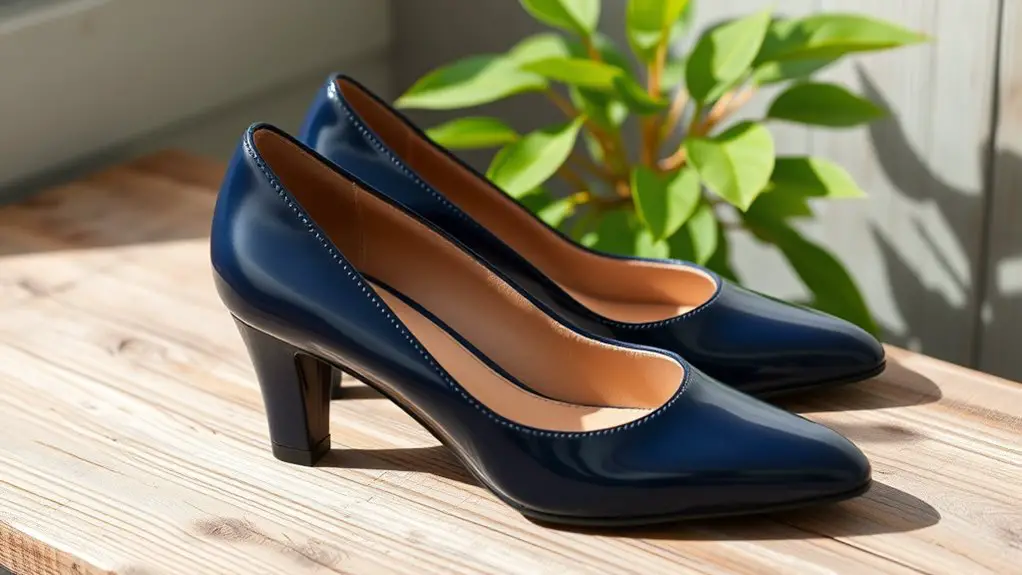If you’re dealing with plantar fasciitis, choosing the right heels is essential. Look for styles with arch support, cushioning, and a moderate heel height (1 to 2 inches). Brands like Vionic, Clarks, and Naturalizer offer fashionable options that prioritize comfort and foot health. Consider block heels or wedges for better stability. Taking breaks and incorporating supportive insoles can also help manage foot pain. You’ll discover more tips and recommendations to enhance your comfort as you explore further.
Understanding Plantar Fasciitis and Its Impact on Footwear Choices

When you have plantar fasciitis, understanding its effects on your footwear choices is essential for managing pain and promoting healing. This condition typically arises from overuse, improper footwear, or biomechanical issues, leading to inflammation of the plantar fascia. Choosing the right shoes can greatly alleviate symptoms and prevent further irritation.
Footwear that lacks adequate support exacerbates the pain, as it fails to provide the necessary arch support and cushioning. High heels, for instance, often place excessive pressure on the plantar fascia, worsening discomfort. Instead, prioritize shoes with a comfortable fit, sufficient arch support, and shock-absorbing soles.
Key Features to Look for in Heels for Plantar Fasciitis
Selecting heels that accommodate plantar fasciitis involves specific features to guarantee comfort and support. First, consider the heel materials; opt for flexible materials that provide cushioning and shock absorption, such as leather or synthetic blends. These materials can help reduce pressure on the heel and arch.
Next, focus on the footbed design. A contoured footbed with arch support is essential, as it helps distribute weight evenly and alleviates strain on the plantar fascia. Look for heels with added cushioning, which can enhance comfort during prolonged wear.
Additionally, verify the heel height is moderate; excessively high heels can exacerbate pain. Platforms can also be beneficial, as they reduce the angle of the foot and provide stability. Finally, pay attention to the shoe’s width, ensuring it accommodates your foot comfortably without pinching. Prioritizing these features can greatly improve your experience in heels while managing plantar fasciitis.
Types of Heels That Offer Support and Comfort

When selecting heels for plantar fasciitis, it’s essential to prioritize cushioning and arch support. You’ll want to take into account heel height as well, as it can greatly impact your overall comfort. Understanding these factors will help you choose footwear that minimizes discomfort and provides the necessary support for your condition.
Cushioning and Arch Support
While finding stylish heels might seem challenging for those with plantar fasciitis, prioritizing cushioning and arch support can greatly enhance comfort and reduce pain. Here are three key factors to evaluate:
- Heel Materials: Opt for heels made from lightweight, flexible materials that provide shock absorption and minimize impact on your feet.
- Footbed Designs: Look for contoured footbeds that cradle your arch and offer additional cushioning. Memory foam or gel inserts can be beneficial.
- Arch Support: Choose heels with built-in arch support to maintain proper foot alignment and prevent strain on your plantar fascia.
Heel Height Considerations
Though it may be tempting to opt for higher heels for style, considering heel height is essential for managing plantar fasciitis symptoms. Lower heels typically offer better heel stability, which can greatly reduce strain on your plantar fascia. Aim for heels that are 1 to 2 inches high, as this height strikes a balance between comfort and elegance. Heels above this range can adversely impact your foot’s biomechanics, leading to increased discomfort. Additionally, styles with a wider base provide more support and distribute weight evenly, further alleviating pressure on sensitive areas. Remember, prioritizing comfort and proper height can make a considerable difference in managing your condition while still allowing you to enjoy fashionable footwear.
Best Brands for Stylish Heels With Arch Support
When selecting heels that accommodate plantar fasciitis, it’s crucial to take into account brands known for their arch support. Several stylish options exist that combine comfort with fashion, allowing you to maintain your aesthetic without sacrificing foot health. In this discussion, we’ll explore top brands that offer both support and chic design.
Top Arch Support Brands
Finding stylish heels that provide sufficient arch support can be challenging, especially for those dealing with plantar fasciitis. Fortunately, several brands focus on arch support innovations, offering supportive heel styles that blend fashion with function. Here are three top arch support brands you should consider:
- Vionic: Known for their podiatrist-designed footwear, Vionic incorporates advanced arch support technology into their stylish heels.
- Clarks: Their heels feature cushioning and arch support to enhance comfort without sacrificing style.
- Naturalizer: This brand specializes in chic designs equipped with built-in arch support, catering to both aesthetic and functional needs.
These brands prioritize comfort, ensuring you don’t have to compromise on style while managing your foot health.
Stylish Heel Options
Choosing stylish heels that also provide arch support is essential for those with plantar fasciitis. Fortunately, several brands offer trendy designs while incorporating supportive materials. Look into brands like Vionic, which is known for its innovative arch support hidden within fashionable styles. Clarks also provides heel options that blend chic aesthetics with comfort, utilizing cushioned insoles and supportive structures. Another excellent choice is Naturalizer, which offers heels that cater to both style and foot health. These brands focus on creating footwear that meets the demands of modern fashion while addressing the specific needs of your feet. By choosing wisely, you can enjoy stylish heels without compromising on support and comfort.
Comfort Meets Fashion
While many women desire stylish heels, those with plantar fasciitis need options that also provide adequate arch support. Fortunately, several brands have embraced fashion trends while ensuring comfort through innovative heel materials. Here are three top brands to evaluate:
- Clarks – Renowned for their cushioned footbeds and arch support, Clarks combines classic designs with modern flair.
- Naturalizer – This brand focuses on ergonomic technology, offering heels that are both chic and supportive, perfect for daily wear.
- Vionic – Known for their podiatrist-designed footbeds, Vionic’s heels integrate style with necessary arch support.
Top Recommended Heels for Women With Plantar Fasciitis
When you’re dealing with plantar fasciitis, selecting the right heels becomes essential for both comfort and support. Look for styles with a cushioned insole and arch support, as these features greatly enhance foot health. Brands such as Vionic and Clarks offer heels designed with orthotic technology that caters specifically to your needs.
Consider block heels or wedges, which provide stability while allowing you to maintain heel fashion. The Naturalizer line also emphasizes comfort without sacrificing style, making it a worthy option. Additionally, you might explore sandals with a slight heel, like those from Dansko, which often provide adequate arch support and shock absorption.
Tips for Wearing Heels While Managing Foot Pain

Although wearing heels can be a challenge for those managing foot pain, implementing a few strategic tips can make the experience more tolerable. Consider these suggestions to help alleviate discomfort while still enjoying your footwear:
Wearing heels while managing foot pain can be challenging, but strategic tips can enhance comfort and enjoyment.
- Choose supportive styles: Opt for heels with arch support and cushioning. Look for heel alternatives that provide stability and comfort.
- Limit wear time: Reduce the duration you wear heels. Start with shorter outings and gradually increase your wear time as your foot adapts.
- Incorporate breaks: Take frequent breaks to rest your feet. Find opportunities to sit down and relieve pressure, which can help minimize foot pain.
Alternative Footwear Options for Special Occasions
Finding suitable footwear for special occasions can be challenging if you have plantar fasciitis, but alternatives exist that combine style with comfort. When selecting wedding shoes or party pumps, look for options with supportive structures, cushioning, and a wider toe box.
Here’s a comparison of popular alternative footwear choices:
| Footwear Type | Key Features |
|---|---|
| Low-heeled Sandals | Adjustable straps, cushioned sole |
| Stylish Flats | Arch support, flexible material |
| Block-heeled Shoes | Stable base, shock absorption |
| Wedge Shoes | Even weight distribution, comfort |
| Orthopedic Dress Shoes | Custom fit, added cushioning |
Caring for Your Feet: Exercises and Stretching for Plantar Fasciitis
To effectively manage plantar fasciitis, incorporating specific exercises and stretching routines into your daily regimen can greatly alleviate discomfort and improve foot function. Here are three effective strategies:
- Calf Stretch: Stand facing a wall, place your hands on it, and step one foot back, keeping it straight. Bend your front knee and lean forward to stretch the calf muscle of the back leg. Hold for 15-30 seconds.
- Towel Stretch: Sit on the floor with your legs extended. Loop a towel around the ball of one foot and gently pull it towards you while keeping your knee straight. This promotes flexibility and pain relief.
- Foot Strengthening: Try toe curls by picking up small objects with your toes. This exercise enhances foot strength and stability, essential for managing plantar fasciitis.
Incorporating these routines can lead to significant pain relief and improved foot health.
Frequently Asked Questions
Can I Wear Heels Every Day With Plantar Fasciitis?
Wearing heels daily with plantar fasciitis isn’t advisable. Proper plantar fasciitis management often requires supportive footwear. Prioritize daily heel comfort, opting for styles that provide adequate arch support and cushioning to alleviate pain and promote healing.
What Heel Height Is Safest for Plantar Fasciitis?
When considering heel height, aim for 1 to 2 inches for ideal comfort levels. Higher heels can exacerbate discomfort, so prioritize stability and proper arch support to manage plantar fasciitis effectively while maintaining foot health.
Are There Specific Brands to Avoid for Plantar Fasciitis?
While you might think all brands are equal, certain common heel types and specific materials can exacerbate plantar fasciitis. Avoid brands with rigid soles or excessive height; prioritizing support and flexibility is essential for relief.
How Do I Break in New Heels Without Worsening Pain?
To break in new heels without worsening pain, try breaking in techniques like wearing them for short periods. Consider heel cushioning options to provide added support, reducing pressure on your feet during this change.
Can Insoles Be Used in Fashionable Heels for Extra Support?
Yes, fashionable insoles can definitely be used in heels to enhance heel comfort. They provide additional support, helping to alleviate pressure on your feet, allowing you to enjoy stylish footwear without compromising on comfort.



